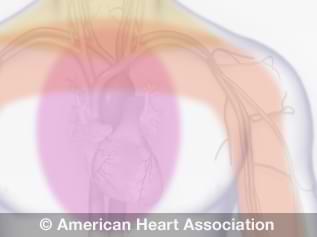Stable Angina
Quick Facts
- Stable angina is the most common type of angina.
- It usually happens during physical activity or emotional stress.
- It is often treated with rest, medications or both.
Angina is chest pain or discomfort due to your heart muscle not getting enough oxygen-rich blood. There are different types of angina. The most common type is stable angina. Stable angina usually happens during physical activity or when you’re having strong emotions.

Symptoms of stable angina
- Chest pain or discomfort that:
- Occurs when the heart must work harder, usually during physical work
- Doesn’t come as a surprise, and bouts of pain tend to be alike
- Usually lasts a short time (five minutes or less)
- Is relieved by rest or medication
- May feel like gas or indigestion
- Pain that spreads down your left shoulder or arm
- Shortness of breath
- Dizziness
- Nausea
- Exhaustion
Possible triggers of stable angina:
- Exercise
- Emotional stress: Learn stress management.
- Being in very cold temperatures: Learn how cold weather affects the heart.
- Smoking: Learn more about quitting smoking.
- Heavy meals
Track your angina symptoms with our Angina Log.
Treatment
People with stable angina have bouts of chest pain. The pain is usually predictable and can be managed. You might feel it while running or if you’re dealing with stress.
This type of chest pain is usually relieved with rest, nitroglycerin or both. Nitroglycerin relaxes the heart arteries and other blood vessels. This reduces the amount of blood that returns to the heart and eases the heart’s workload. Relaxing the arteries increases the heart’s blood supply.
Your health care professional may prescribe other medications to prevent angina. They may include:
- Beta-blockers and calcium channel blockers to lower blood pressure and heart rate and reduce the heart’s workload
- Angiotensin-converting enzyme (ACE) inhibitors and angiotensin II receptor blockers to reduce blood pressure and the risk of heart attack
- Statins to reduce LDL (bad) cholesterol
- Antiplatelet drugs or aspirin to help prevent blood clots
- Ranolazine to treat chronic angina that doesn’t respond to other medications
If you feel chest pain, contact your health care team right away. If you have stable angina and start getting chest pain more easily and more often, see your health care professional right away. You may be having early signs of unstable angina.







